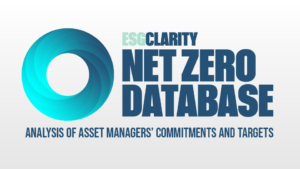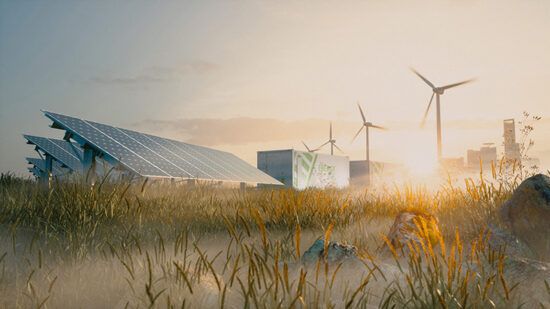We are on the cusp of a “fourth industrial revolution based around climate” and investors need to be prepared to understand how that will impact the investable universe, said CEO of CFA UK Will Goodhart in this video interview with ESG Clarity EU.
Goodhart also shared how the pushback in the US on ESG is a sign the market is maturing, and why he thinks the momentum towards sustainable investing is “irreversible”. He discusses the success of the recent ESG and climate certificates and why the CFA is looking to break those down further with certificates in impact and natural capital.
Watch the full video interview above and read the transcript below.
NK: Hello and welcome to this special interview for ESG Clarity. I’m joined by Will Goodhart, CEO of CFA UK. Thanks so much for taking the time to come in and speak with us today. We last caught up on a Zoom interview over a year ago. What have been the key developments for ESG investors from a CFA perspective since then?
WG: Gosh, well, it’s awfully nice to be back and be able to meet in person – that’s pretty important development, I am very pleased about that. Lots of things have gone on in ESG world. In terms of a positive development, the market is maturing and I’ll come back to that.
The maturity and the importance of the market has also been reflected in the amount of pushback that we’ve seen over the past 12 months, particularly perhaps in North America. So there has been quite a lot of concern about ESG, and a lot of that comes from a misunderstanding of what ESG is, because at its basic level, ESG is just three factors environmental, social and governance factors – it’s not really a strategy. It’s just saying ‘this is more information’ [on these factors].
A lot of what ESG is is ESG integration. It’s just taking that into your existing investment processes and saying ‘having more information is probably better than having less information’.
It’s not necessarily exclusions, it’s not old fashioned ethical investing. And I can understand that there are many people who would want that, but there are many people who wouldn’t want that because of the impact on the investable universe.
But it is simply, from our perspective and from a CFA perspective, good investment practice. What we’re seeing in terms of the maturity of the market, it’s partly because people want to get away from that generalised critique of everything is ESG. That’s not really true, and you see that now also in regulation. So you’ve got the SEC and FCA working just to distinguish different types of sustainable investment. And they’re talking about sustainable investment – they’re not talking about ESG, they’re talking about something that has some specific purpose to change things.
That I think is a useful development because it gives people a clearer understanding of the spectrum of sustainable investing. And now we’ve got impact investing, and the impact itself has got probably light versus more profound impact, then you have sustainable – and that might be thematic or it might be climate so it might be quite generalised, and then you’ve got ESG, which could be more profound or really could be quite light. It just might be integration, in which case, frankly, it’s just investing now. So I think ESG investing is becoming just mainstream investing in terms of integration.
And the rest of the market is bedding down into different areas and our understanding of what the promises from those different areas is becoming clearer, partly through regulation and partly just through good practice.
NK: Okay, fantastic. Thank you for talking to us through that. And the CFA recently launched a certificate focusing on climate. Could you talk us through that and maybe talk about what the uptake has been like?
WG: Yeah, no, absolutely. The uptake has been good, which is great. We’re well through the 1,000 now, which is terrific because what that should mean is we start to get that sort of feedback loop for those people coming back into the market saying ‘actually I’ve really enjoyed that, found it very useful, thanks very much’ and advising their colleagues, their friends that if you want to know about climate, this is probably the way that you should go.
We would expect that to start accelerating in the same way that we saw from ESG. We’ve also launched a second version of climate, makes it a little bit easier to work through based on feedback that we got from the first lot.
So now we have two volumes each a little bit shorter, but there is a lot to learn about climate, and that’s really why we launched the certificate, because we have coverage of climate in the certificate on ESG investing, but it’s quite brief and I think the certificate in ESG investing now, the learning materials is something like 550 pages – climate within that is probably 30 to 50 pages. Our certificate on climate investing is about 600 pages, and that’s because there’s an awful lot to know about. You’ve got to understand the science, you’ve got to understand the data, you’ve got to understand the regulation. And then there are skills that are specific to climate because the exciting thing I think from an investment point of view about climate is that it’s forward looking.
See also: – What it’s like to take the CFA Certificate in ESG Investing
A lot of investment is checking on the data from the past and sort of figuring out the correlations and the sort of statistical relationships between asset class. Lots of those things are going to break down because of climate. It’s just not going to be sort of persistent going forward. So you need people who are good at scenario analysis, you need people who are good at stewardship, and those are skills that not everybody has. I’ve just been looking at a bit of history and apparently the canals, the canal sector was the biggest sector in the FTSE, well it wasn’t the FTSE then I’m not even sure what it was called, but on the London Stock Exchange in about 1840 and in 1860 it’s gone, just gone. Railways were then the biggest they hadn’t gone completely by 1880, but they were well on their way out, and you just start to see oil and gas coming through. We’re at the beginning of a of another industrial revolution, a fourth industrial revolution based around climate and our need to respond to climate. That’s going to change the investable universe and people need to be able to know how to work in that.
NK: I really hope we do get to see that rapid change like the examples you just gave. We really do need to see it, don’t we? And are you still planning to launch an impact investing certificate?
WG: We are, thank you for asking. As the market is maturing, people are very keen to demonstrate that they’re creating real change. There are lots of very valuable investment practices that are operated by funds, by investment houses that maybe where you can’t necessarily show precise change. But I think some investors are anxious to see particular areas of change. Now that may be in social areas or it may be to do with education opportunities for women in certain markets, it might be to do with the development of health opportunities in different places, it might be to do with reforestation, or it might be to do with the development of renewables. But what people want is to have explained to them a theory of change and then to see from the fund how that theory of change is being implemented and to see the results of that.
And that’s really what impact investing is about. It’s about wanting to change something, being explicit about the thing you’re trying to change, and then telling people how you have or have not changed because like any other form of investing, it won’t always work. But you need to be sort of transparent. You need to be honest about that. So impact is becoming a particular discipline. I’ve referenced theory of change, which for those of us who’ve had anything to do with impact is something we understand but actually takes a little while to get your head around. Then there’s impact due diligence. What should you be looking for in an investment opportunity to be conscious of what impact is possible from that and then impact reporting again, it’s different.
These are not completely different disciplines, but there are additional disciplines that existing investment professionals will probably want to build into their skill sets.
NK: Any other certificates planned?
WG: One more! On natural capital because, and again, it’s a sort of natural follow on from impact, but it’s a more specific area and that’s a little bit because, like climate, there’s quite a lot to understand and about biodiversity, the science of biodiversity, the complexity of biodiversity and then the different areas that you can try to target to promote biodiversity and how you can then deliver private capital to those.
We’re still at a relatively early stage on that. We don’t yet have a fixed syllabus, but we will work on that during the next three to four months, we will then spend about six months writing the materials, and I would hope that we will be piloting a certificate in natural capital or biodiversity, not picked the name yet, sometime after the summer of next year.
NK: Okay, fantastic. Yes, we’re definitely seeing an increasing focus on that from our readers. And I’m coming back to the point you made on the anti-ESG rhetoric that we’re seeing in the US, how is that affecting the take-up of the certificates, if at all? And what’s your general outlook for sustainable investing?
WG: I think the outlook for sustainable investing is fine actually.
I think that there is an irreversible momentum towards that, and that’s partly because policy and regulation is all going that way. And that’s not just from, you know, governing parties wherever in the world of particular flavour – pretty much all those in government, with perhaps a couple of notable exceptions, are seeing the importance of actually addressing climate change and starting to direct policy and regulation in that way.
I think that sustainable investing has a very positive future. As I say, I think the market will become more mature. I think we will see sorts of different parts of that sustainable investing market start to build their own identity, their own profile. If we started with the ESG and we are slightly leaving ESG behind, we’ve moved towards sustainable investing and sustainable investing perhaps might become an umbrella that we use slightly less and we start to use a bit more climate, biodiversity, impact and those different pieces of it start to build their own standards, their own practices. And that’s certainly what we’re seeing and that’s actually why you’re able to build a learning program, a certificate around that, because good practice is now understood. And so now what we can do is talk to the people who are doing that and explain that to others.
NK: Fantastic. Thank you very much for sharing all of your insights of us. Really great to have you in and I will hopefully see you again next year.
WG: Lovely. That’ll be fabulous. Thank you.








